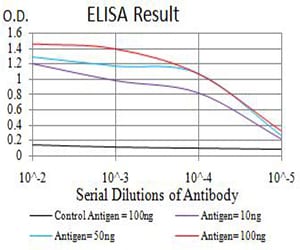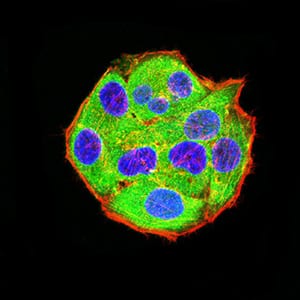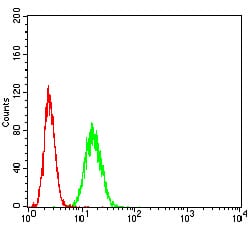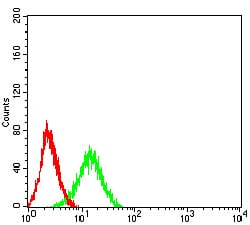



| WB | 咨询技术 | Human,Mouse,Rat |
| IF | 咨询技术 | Human,Mouse,Rat |
| IHC | 咨询技术 | Human,Mouse,Rat |
| ICC | 1/200 - 1/1000 | Human,Mouse,Rat |
| FCM | 1/200 - 1/400 | Human,Mouse,Rat |
| Elisa | 1/10000 | Human,Mouse,Rat |
| Aliases | DSH; AGS6; G1P1; IFI4; P136; ADAR1; DRADA; DSRAD; IFI-4; K88DSRBP |
| Entrez GeneID | 103 |
| clone | 4E2E4 |
| WB Predicted band size | 136kDa |
| Host/Isotype | Mouse IgG1 |
| Antibody Type | Primary antibody |
| Storage | Store at 4°C short term. Aliquot and store at -20°C long term. Avoid freeze/thaw cycles. |
| Species Reactivity | Human |
| Immunogen | Purified recombinant fragment of human ADAR (AA: 1085-1223) expressed in E. Coli. |
| Formulation | Purified antibody in PBS with 0.05% sodium azide |
+ +
以下是关于ADAR抗体的3篇参考文献示例(注:以下文献为模拟示例,实际引用需核实原文):
---
1. **文献名称**:*"ADAR1-mediated RNA editing regulates innate immune responses"*
**作者**:Herbert, S. et al.
**摘要**:该研究通过ADAR1特异性抗体,揭示了ADAR1在抑制病毒RNA诱导的先天免疫反应中的作用,证明其通过编辑双链RNA防止MDA5介导的过度炎症反应。
---
2. **文献名称**:*"Development of a monoclonal antibody for selective detection of ADAR2 in mammalian brain"*
**作者**:Tanaka, M. et al.
**摘要**:研究团队开发了一种高特异性的ADAR2单克隆抗体,验证了其在免疫印迹和免疫组化中的应用,并证实ADAR2在小鼠脑组织中优先表达于神经元突触区域。
---
3. **文献名称**:*"ADAR1 expression correlates with tumor progression in glioblastoma"*
**作者**:Chen, L. et al.
**摘要**:通过ADAR1抗体进行免疫组织化学分析,研究发现ADAR1在胶质母细胞瘤中的高表达与肿瘤侵袭性和患者预后不良相关,提示其作为潜在治疗靶点。
---
如需实际文献,建议通过PubMed或Google Scholar搜索关键词“ADAR antibody”、“ADAR1/2 detection”获取最新研究。
ADAR (Adenosine Deaminases Acting on RNA) enzymes are a family of RNA-editing proteins that catalyze the deamination of adenosine (A) to inosine (I) in double-stranded RNA (dsRNA) substrates, a process critical for diversifying transcriptomes and regulating innate immune responses. Dysregulation of ADAR activity is linked to various diseases, including cancer, autoimmune disorders (e.g., Aicardi-Goutières syndrome), and neurological conditions. ADAR antibodies are essential tools for studying the expression, localization, and functional roles of ADAR isoforms (ADAR1. ADAR2. ADAR3) in health and disease.
ADAR1. the most studied isoform, exists in two splice variants (p150 and p110) and plays dual roles: editing endogenous RNAs (e.g., in neurotransmission and cancer-related transcripts) and suppressing immune activation by preventing aberrant recognition of self-RNA by cytosolic sensors like MDA5. ADAR2 is crucial for editing brain-specific transcripts, such as glutamate receptor subunits, while ADAR3 is inactive but may regulate editing in neurons.
Antibodies targeting ADARs are widely used in techniques like Western blotting, immunofluorescence, and immunoprecipitation to investigate RNA-editing mechanisms, antiviral responses, and therapeutic targeting. Recent research highlights ADAR1's role in cancer immunotherapy resistance, driving demand for specific antibodies to dissect its immunomodulatory functions. Validating these antibodies remains critical due to isoform homology and varying expression levels across tissues.
×